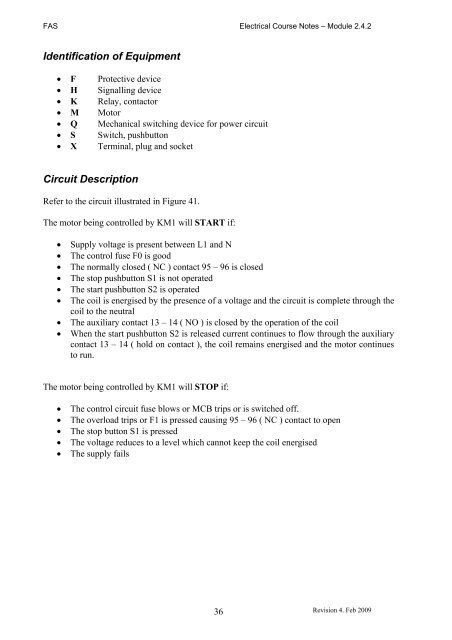Trade of Electrician Motor Control COURSE NOTES - eCollege
Trade of Electrician Motor Control COURSE NOTES - eCollege
Trade of Electrician Motor Control COURSE NOTES - eCollege
You also want an ePaper? Increase the reach of your titles
YUMPU automatically turns print PDFs into web optimized ePapers that Google loves.
FAS Electrical Course Notes – Module 2.4.2<br />
Identification <strong>of</strong> Equipment<br />
F Protective device<br />
H Signalling device<br />
K Relay, contactor<br />
M <strong>Motor</strong><br />
Q Mechanical switching device for power circuit<br />
S Switch, pushbutton<br />
X Terminal, plug and socket<br />
Circuit Description<br />
Refer to the circuit illustrated in Figure 41.<br />
The motor being controlled by KM1 will START if:<br />
Supply voltage is present between L1 and N<br />
The control fuse F0 is good<br />
The normally closed ( NC ) contact 95 – 96 is closed<br />
The stop pushbutton S1 is not operated<br />
The start pushbutton S2 is operated<br />
The coil is energised by the presence <strong>of</strong> a voltage and the circuit is complete through the<br />
coil to the neutral<br />
The auxiliary contact 13 – 14 ( NO ) is closed by the operation <strong>of</strong> the coil<br />
When the start pushbutton S2 is released current continues to flow through the auxiliary<br />
contact 13 – 14 ( hold on contact ), the coil remains energised and the motor continues<br />
to run.<br />
The motor being controlled by KM1 will STOP if:<br />
The control circuit fuse blows or MCB trips or is switched <strong>of</strong>f.<br />
The overload trips or F1 is pressed causing 95 – 96 ( NC ) contact to open<br />
The stop button S1 is pressed<br />
The voltage reduces to a level which cannot keep the coil energised<br />
The supply fails<br />
36<br />
Revision 4. Feb 2009

















